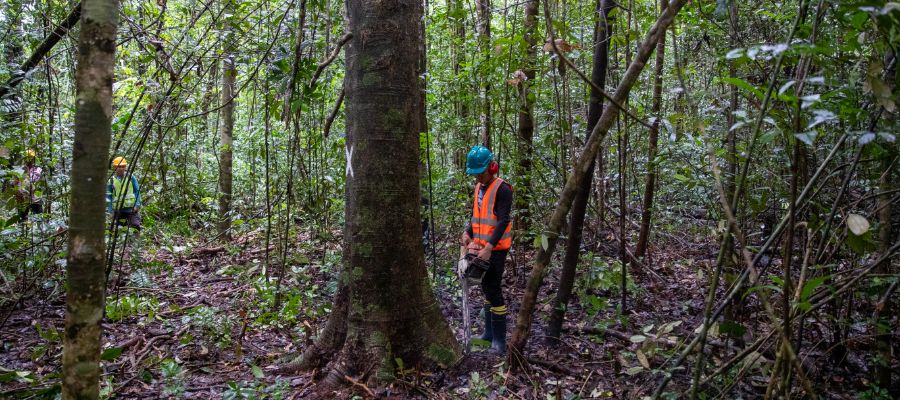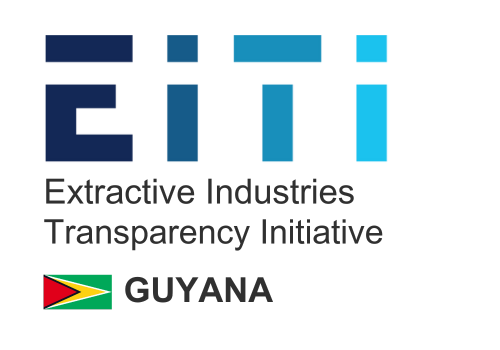
Overview
Forests cover nearly 19.3 million hectares79 of Guyana total landmass of 21 million80 hectares. However, about 12.6 million hectares81 of the forestland have been designated as State Forests and placed under the management of the Guyana Forestry Commission. Indigenous peoples manage (approximately 14%)82 of the forest surface and the rest have been designated as protected and research areas divided in the following five (5) areas:
– Kaieteur National Park;
– Iwokrama forest 180,000 hectares;
– Kanuku Mountains Protected Area;
– Konashen Community Conservation Area; and
– Shell Beach Protected Area, which includes mangrove forests..
The updated forest resources allocation map is published on the Guyana Forestry Commission website and can be found here. The Guyana’s forests contain more than a thousand different tree species of which over 12 species are being logged on a commercial scale through concessions83. The most economically valuable timber species include:
– Greenheart (Colubrina Arborescens or Chlorocardium Rodiei84);
– Purpleheart (Peltogyne spp. Vogel85) ;
– Mora (Mora excelsa Benth. and M. gonggrijpii86) );
– Baromalli ((Catostemma87) ); and
– Crabwood (Catostemma88) )
Despite the fact that deforestation rates typically expand with economic development, the forestry sector in Guyana has successfully emerged against an increase in production when compared to 2017 with an extremely low deforestation rate of 0.051% in 202089 . This equates to an annualised deforestation rate of 0.051% which is slightly higher than the change reported in the previous year (0.048%).90The main deforestation driver for the current forest year reported is mining (sites), which accounts for 75% of the deforestation in this period. The majority (78%) of the deforestation is observed in the State Forest Area.91 Guyana established a National Protected Areas System which currently comprises of approximately 8.4% of Guyana’s landmass and includes: Kaieteur National Park;Kanashen Community Owned Conservation Area; Kanuku Mountains Protected Area; Shell Beach Protected Area; Urban Parks,National Park, Botanical Gardens, Zoological Park and Vieira Park. The Protected Areas are recognized as scientific research sites as well as eco-tourism destinations that earn revenues and provide livelihoods and are carbon sinks. The GFC published 2020 MRVS report in September 2021. s its annual review report which provides a detailed overview on the forestry sector including the economic environment, the forestry sector structure, production data and employment. The most recent annual review report relates to 2020 and can be accessed here. The GFC and the sector are entering an implementation phase of the EU Forest Law Enforcement Governance and Trade (FLEGT) Voluntary Partnership Agreement (VPA) as well as the National Forest Plan and Policy. Inactivity or underutilised forest areas will be put to productive use thereby creating more job opportunities as well as contribution to national production, export and overall GDP. GFC will continue its work on Forest and Climate Change as well as on Forest Area Assessment and reporting on Deforestation and Forest Degradation under REDD+ and supporting the Government’s Green State Development Strategy.92 At the policy level there have been several interventions and policy developments that will further support the development of the sector. These include Cabinet approval of the revised National Forest Plan and Policy Statement 2018, and the tabling and passage in Parliament of the forestry regulations to support the Forest Act of 2011. On 23 November 2018, the Government of Guyana, through the GFC, initialled the Voluntary Partnership Agreement under the EU Forest Law Enforcement Governance and Trade Programme (VPA EU FLEGT).93 On 9 November 2009, Guyana and Norway signed a Memorandum of Understanding (MoU) on cooperation in the fight against climate change, in particular on reducing emissions from deforestation and forest degradation in developing countries (REDD+), protecting biodiversity and enhancing sustainable low carbon development. An accompanying Joint Concept Note set out the framework. The Joint Concept Note came into force as part of the Low Carbon Development Strategy (LCDS) and has been given a time extension. The Joint Concept Note (JCN) is reviewed and updated annually. It is related to REDD+ and Guyana’s commitments to afforestation and incentives to keep Guyana’ rain forests standing and well managed with an agreed Forest Reference Level (FRL) that is the basis of the national Monitoring, Reporting and Verification System (MRVS). Guyana’s MRVS has been internationally recognised and acclaimed as a Model. There are also successful initiatives in Community Monitoring, Reporting and Verification (CMRV) in North and South Rupununi land with the Wai Wai that are harmonised with the National MRVS. The MRVS aims to establish a comprehensive, national system to monitor, report and verify forest carbon emissions resulting from deforestation and forest degradation in Guyana. The first year of the roadmap commencement was 2010, which required several initial reporting activities to commence. These were designed to assist in shaping the next steps planned for the following years. In 2014, a Phase 2 Roadmap was developed for the MRVS. The overall objective of the Roadmap Phase 2 sought to consolidate and expand capacities for national REDD+ monitoring and MRV. This supported Guyana in meeting the evolving international reporting requirements from the United Nations Framework Convention on Climate Change (UNFCCC) while continuing to fulfil additional reporting requirements. In 2020, Guyana developed its Phase 3 Roadmap. This charted the path forward for the next phase of the MRVS to a fully operational forest carbon reporting platform, suitable for a potential market-based mechanism and meeting all UNFCCC recommendations. To date, ten national assessments (2010 to 2020) have been conducted. The Year 2020 assessment, support the establishment and long-term sustainability of a world-class MRVS, as a key component of Guyana’s national REDD+ programme. This system will further expand the basis for verifiably measuring changes in Guyana’s forest cover and resultant carbon emissions from Guyana’s forests as an underpinning for results-based REDD+ compensation in the long term.94 In Guyana, the REDD+ strategy is developed through a participatory approach with national and local stakeholders and is based on the country’s sustainable development priorities. In April 2018, The Ministry of Natural Resources contracted a consortium led by Winrock International and Conservation International to design Guyana’s REDD+ strategy and Strategic Environmental and Social Assessment report, including the Environmental and Social Management Framework. REDD+ represents countries’ efforts to Reduce Emissions from Deforestation and forest Degradation, plus foster conservation, sustainable management of forests, and enhancement of forest carbon stocks. The REDD+ mechanism represents countries’ efforts to reduce emissions from deforestation and forest degradation, as well as to promote conservation, sustainable management of forests and enhancement of forest carbon stocks. REDD+ is a framework through which developing countries are financially rewarded for reducing greenhouse gas emissions or increasing the removal of carbon dioxide from the atmosphere through practices on forest lands. In addition, REDD+ can generate other important benefits beyond climate change mitigation, such as positive impacts on biodiversity, climate change adaptation, low-emission development and strengthening the rights and livelihoods of forest people.
Institutional Framework
The Guyana Forestry Commission (GFC)138 is responsible for the administration and management of all State-forest land in Guyana and for advising the Minister on issues relating to forest policy, forestry laws and regulations. The work of the Commission is guided by several legislations including the Forest Act 2009, the Guyana Forestry Commission Act 2007, the Forest Regulations 2018, the National Forest Policy Statement and the National Forest Plan 2018 that has been developed to address the forestry policy. Additionally, the Commission develops and monitors standards for forestry sector operations, develops and implements forest protection and conservation strategies, oversees forest research and provides support and guidance to forest education and training.
In February 2018 the Guyana Forestry Commission presented140 the revised National Forest Policy and approved it142 as well as the National Forest Plan143. It is suggested that the policy and plan should be read together, in order to improve understanding of their contents and facilitate their implementation. This plan can therefore be seen as an implementation plan for the policy. The main objective of the current National Forest Policy is the conservation, protection, management and use of the forest resources of Guyana, while ensuring that the productive capacity of the forests is maintained or enhanced. The Guyana Lands and Surveys Commission (GLSC) is the main agency responsible for land surveying and administration in Guyana. It is responsible for the purchase and lease of all public lands in Guyana.
The main roles of the commission are to:
- execute geodetic, topographic, hydrographic, and cadastral surveys;
- prepare and publish maps and charts of Guyana;
- maintain the national survey control system;
- check, improve, record and, where required, certify all land surveys carried out in relation of any land in Guyana; and
- collect and account for all purchase funds and rents, payable in relation to the sale or lease of public lands, and such rates, taxes, fees, fines and charges.
The Protected Areas Commission (PAC) was established by the Protected Areas Act (2011) and became operational in 2012. It falls under the purview of the Office of the President. It is governed by a Board of Directors, with a mandate to establish, manage, maintain, promote, and expand the National Protected Areas System (NPAS). The Commission directly manages BPA, KNP, KMPA, and the Urban Parks. Iwokrama is governed under the Iwokrama Act and an International Board of Directors. Kanashen Village Council is the management authority for the KAPA and is responsible for its management. The PAC provides technical support to both Iwokrama and KAPA.
The other main Government Agencies involved in the forestry sector are GRA, NIS, EPA and PTCCB. Their overall roles have been set out in Section 3.2.2(a) of this report.
Legal Framework
The Guyanese forestry sector is governed by the following main legislations:
List of main laws governing the forestry sector
The Forests Act (2009)
This Act repealed the following acts:
- the Forests Act (1998);
- the Forests (Exploratory Permits amendment) Act (1997);
- the Balata Act (1997);
- Guyana timber export Act (1998); and Timber marketing Act (1998).
- It promotes the use of sustainable forestry, through participation with local communities. It also covers the declaration of protected areas within the framework of the Environmental Protection Act (1996) and the set-up of a code of practice. Furthermore, it aims to improve coordination with the mining sector and as a result a public consultation before a license for mining or petroleum prospecting can be granted.
- The Act also allows for the Guyana Forestry Commission (GFC) to enter into forestry concession agreements and community forest management agreements.
The State Land Regulations (1973)
The regulations provide details on grants, licenses and permissions for use of land. These include surveying, grants for small scale cultivation, leases, grazing permissions and various licenses including for occupation and cutting
Guyana Forestry Commission Act (2007)
- This Act repeals the Guyana Forestry Commission Act (1979). It provides for the creation and functions of the Guyana Forestry Commission.
- The Acts promotes the role of the Commission in developing forestry policies, providing inspection, certification and accreditation services for quality control of forest produce.
Forests (Amendment) Regulations (2018)
These regulations make further provisions for
timber sale agreements granting exclusive
rights for cutting and taking or obtaining
forest produce over any area of state forests.
Iwokrama International center for rain forest conservation and development Act (1996)
This act implements provisions of the agreement between the Government of Guyana and the Commonwealth Secretariat for the setup of the Iwokrama International Centre for Rain Forest
Conservation and Development of 1996.
Pesticides and Toxic Chemicals Control Board Act (2000) and subsequent regulations
This act established the Pesticides and Toxic Chemicals Control Board and regulates the manufacture, import, transportation, storage, sale, use and disposal of pesticide
This act provides for the protection and conservation of Guyana’s natural capital through the creation, management and financing of National Protected Areas System (NPAS).

